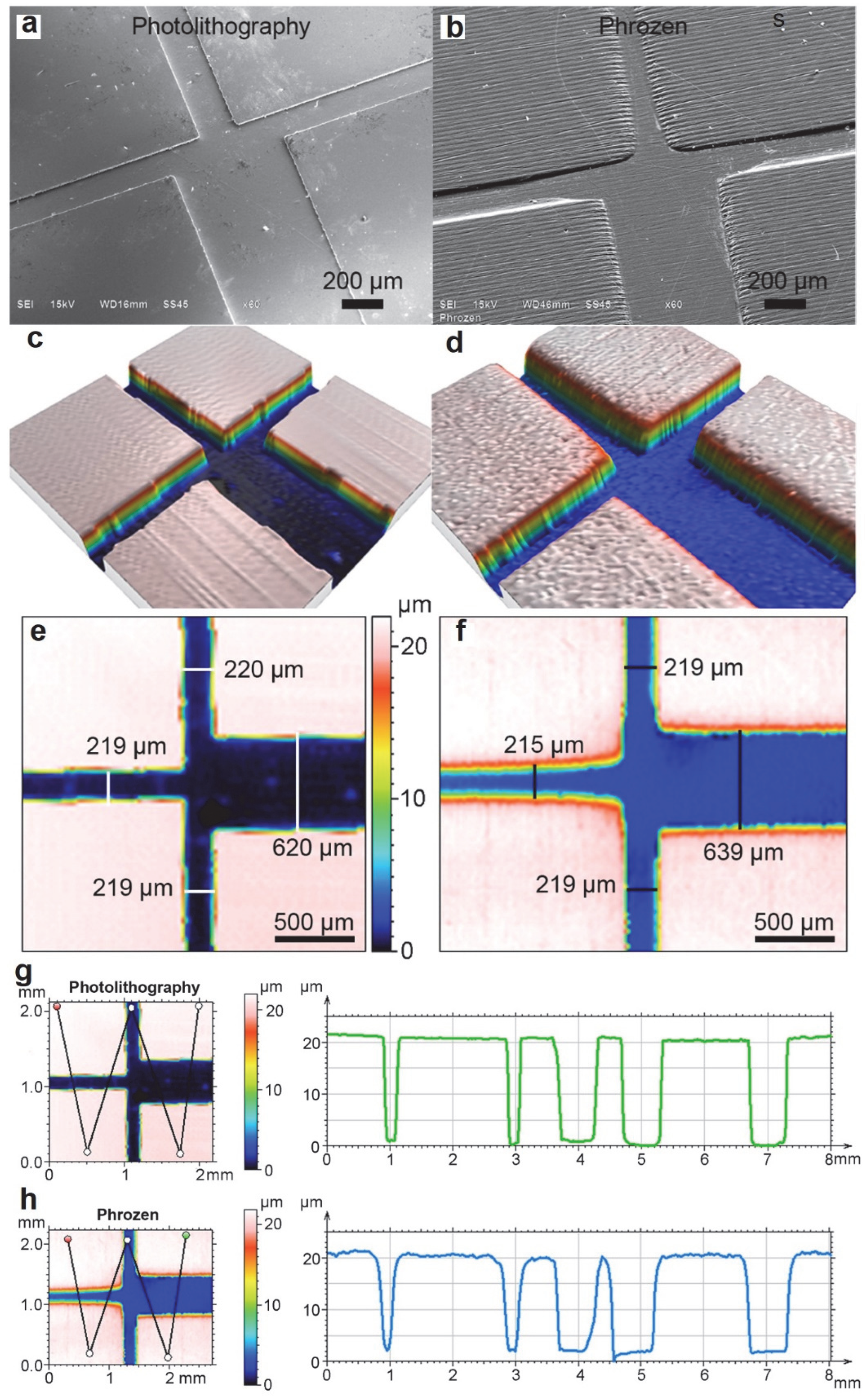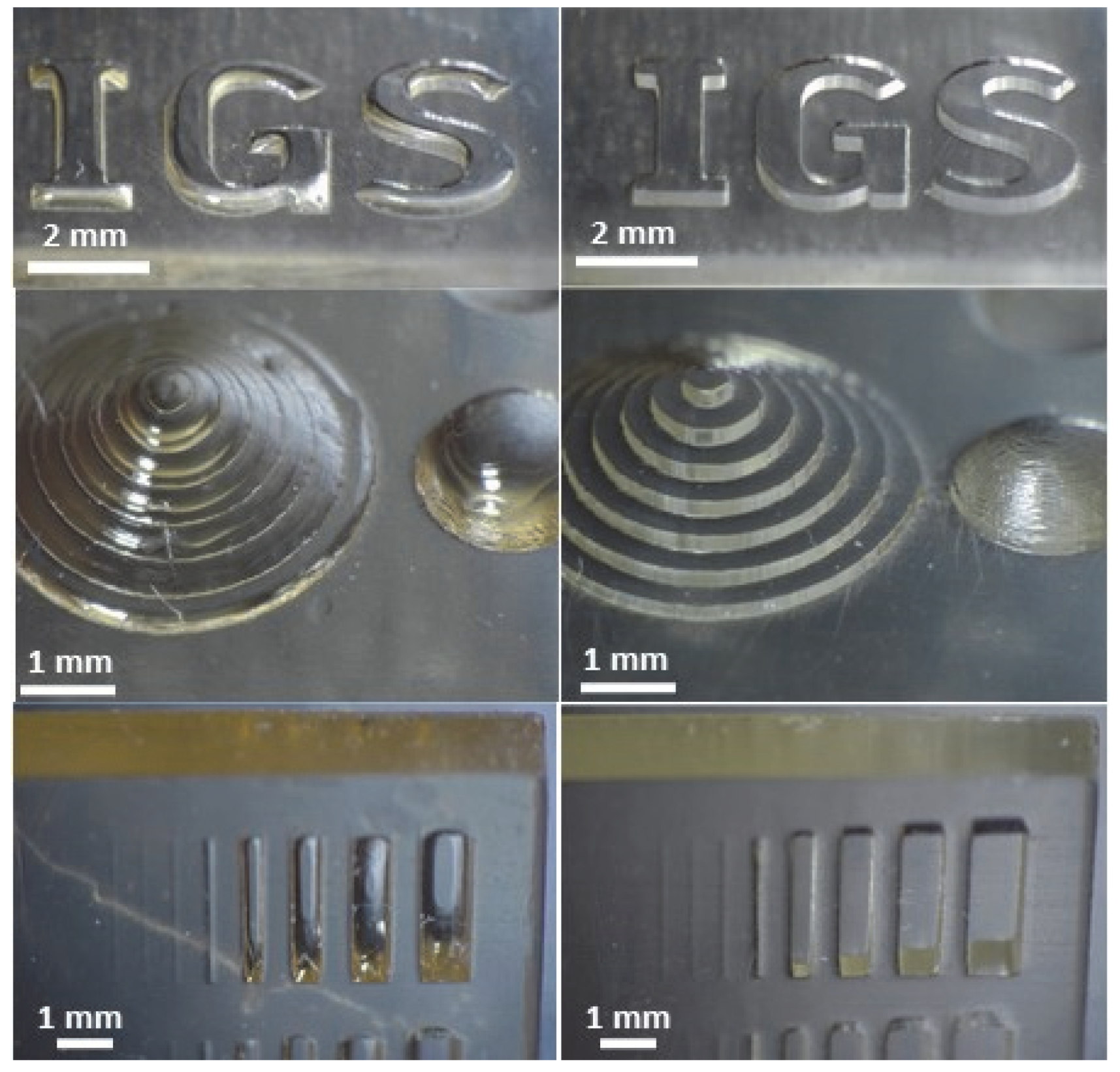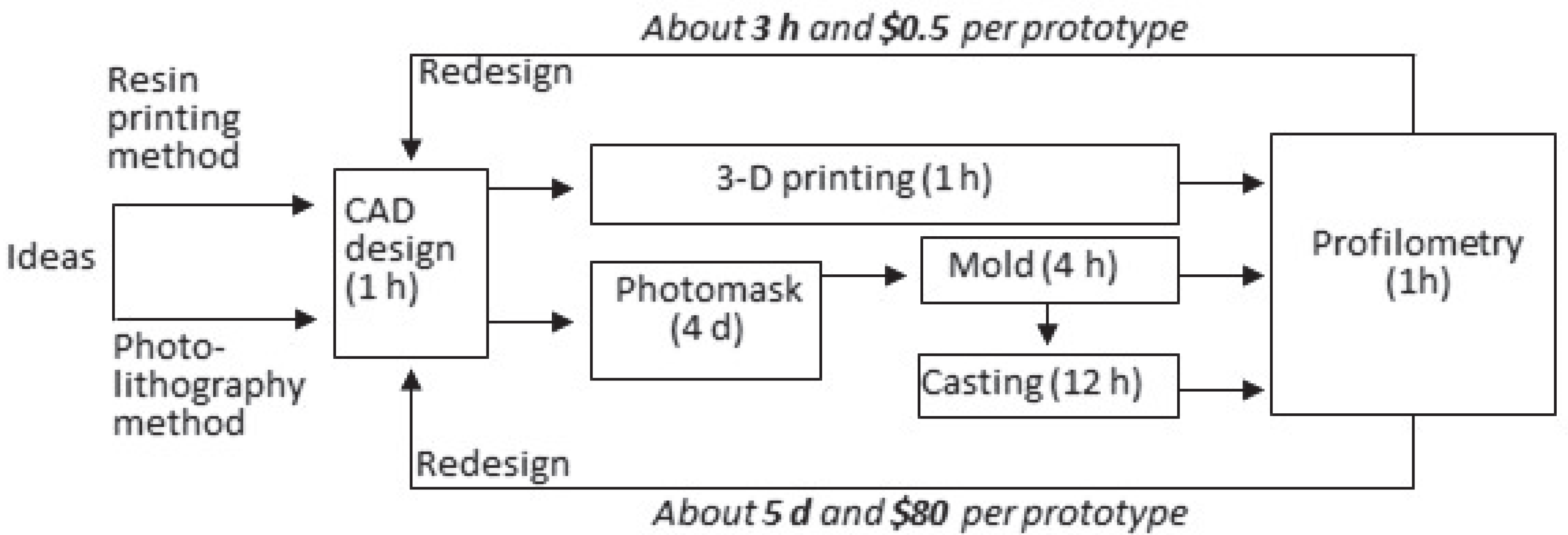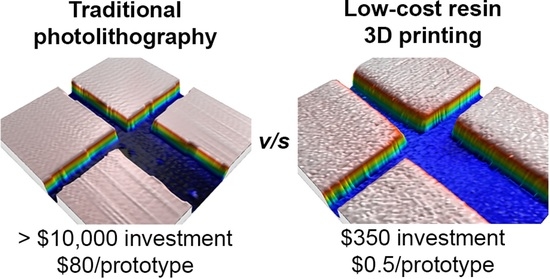Low-Cost Resin 3-D Printing for Rapid Prototyping of Microdevices: Opportunities for Supporting Aquatic Germplasm Repositories
Abstract
:1. Introduction
2. Materials and Methods
2.1. 3-D Printing
2.2. Microfabrication by Traditional Photolithography
2.3. Evaluation of Fabrication Quality
2.4. Evaluation of Pre-Processing and Post-Processing
2.5. Printer Modification for Surface Smoothness
2.6. Comparison of Cost and Time Efficiencies
3. Results and Discussion
3.1. Fabrication Quality
3.2. Pre-Processing
3.3. Post-Processing
3.4. Printer Modification
3.5. Time and Cost Efficiency
4. Conclusions
Author Contributions
Funding
Data Availability Statement
Acknowledgments
Conflicts of Interest
References
- Torres, L.; Tiersch, T.R. Addressing reproducibility in cryopreservation, and considerations necessary for commercialization and community development in support of genetic resources of aquatic species. J. World Aquac. Soc. 2018, 49, 644–663. [Google Scholar] [CrossRef] [PubMed]
- Torres, L.; Liu, Y.; Guitreau, A.; Yang, H.; Tiersch, T.R. Challenges in development of sperm repositories for biomedical fishes: Quality control in small-bodied species. Zebrafish 2017, 14, 552–560. [Google Scholar] [CrossRef] [PubMed]
- Liu, Y.; Blackburn, H.; Taylor, S.S.; Tiersch, T.R. Development of germplasm repositories to assist conservation of endangered fishes: Examples from small-bodied livebearing fishes. Theriogenology 2019, 135, 138–151. [Google Scholar] [CrossRef]
- Olanrewaju, A.; Kareem, O.; Orisasona, O. Cryopreservation: A viable tool for sustainable catfish aquaculture industry in Nigeria. J. Fish. Livest. Prod. 2015, 3, 2. [Google Scholar]
- Yang, H.; Huo, Y.; Yee, J.C.; Yarish, C. Germplasm cryopreservation of macroalgae for aquaculture breeding and natural resource conservation: A review. Aquaculture 2021, 544, 737037. [Google Scholar] [CrossRef]
- Liu, Y.; Monroe, W.T.; Belgodere, J.; Choi, J.-W.; Gutierrez-Wing, M.T.; Tiersch, T.R. The emerging role of open technologies for community-based improvement of cryopreservation and quality management for repository development in aquatic species. Anim. Reprod. Sci. 2021, 106871, in press. [Google Scholar] [CrossRef]
- Liu, Y.; Chesnut, M.; Guitreau, A.; Beckham, J.; Melvin, A.; Eades, J.; Tiersch, T.R.; Monroe, W.T. Microfabrication of low-cost customisable counting chambers for standardised estimation of sperm concentration. Reprod. Fertil. Dev. 2020, 32, 873–878. [Google Scholar] [CrossRef]
- Park, D.S.; Egnatchik, R.A.; Bordelon, H.; Tiersch, T.R.; Monroe, W.T. Microfluidic mixing for sperm activation and motility analysis of pearl Danio zebrafish. Theriogenology 2012, 78, 334–344. [Google Scholar] [CrossRef] [Green Version]
- Beckham, J.; Alam, F.; Omojola, V.; Scherr, T.; Guitreau, A.; Melvin, A.; Park, D.S.; Choi, J.W.; Tiersch, T.R.; Monroe, W.T. A microfluidic device for motility and osmolality analysis of zebrafish sperm. Biomed. Microdevices 2018, 20, 67. [Google Scholar] [CrossRef]
- Lien, K.-Y.; Lee, S.-H.; Tsai, T.-J.; Chen, T.-Y.; Lee, G.-B. A microfluidic-based system using reverse transcription polymerase chain reactions for rapid detection of aquaculture diseases. Microfluid. Nanofluid. 2009, 7, 795. [Google Scholar] [CrossRef]
- Yin, J.; Gao, W.; Zhang, Z.; Mai, Y.; Luan, A.; Jin, H.; Jian, J.; Jin, Q. Batch microfabrication of highly integrated silicon-based electrochemical sensor and performance evaluation via nitrite water contaminant determination. Electrochim. Acta 2020, 335, 135660. [Google Scholar] [CrossRef]
- Weibel, D.B.; Diluzio, W.R.; Whitesides, G.M. Microfabrication meets microbiology. Nat. Rev. Microbiol. 2007, 5, 209–218. [Google Scholar] [CrossRef] [PubMed]
- Bazaz, S.R.; Kashaninejad, N.; Azadi, S.; Patel, K.; Asadnia, M.; Jin, D.; Ebrahimi Warkiani, M. Rapid Softlithography Using 3D-Printed Molds. Adv. Mater. Technol. 2019, 4, 1900425. [Google Scholar] [CrossRef]
- Yazdi, A.A.; Popma, A.; Wong, W.; Nguyen, T.; Pan, Y.; Xu, J. 3D printing: An emerging tool for novel microfluidics and lab-on-a-chip applications. Microfluid. Nanofluidics 2016, 20, 50. [Google Scholar] [CrossRef]
- Quan, H.; Zhang, T.; Xu, H.; Luo, S.; Nie, J.; Zhu, X. Photo-curing 3D printing technique and its challenges. Bioact. Mater. 2020, 5, 110–115. [Google Scholar] [CrossRef]
- Zhou, Y. The recent development and applications of fluidic channels by 3D printing. J. Biomed. Sci. 2017, 24, 80. [Google Scholar] [CrossRef] [Green Version]
- Huo, Y.; Yee, J.C.; Yang, H. Development of a cost-effective and portable aeration freezing system for germplasm cryopreservation for eastern oysters and other aquatic species. Aquacult. Res. 2022, 53, 453–466. [Google Scholar] [CrossRef]
- Minin, A.; Blatov, I.; Rodionov, S.; Zubarev, I. Development of a cell co-cultivation system based on protein magnetic membranes, using a MSLA 3D printer. Bioprinting 2021, 23, e00150. [Google Scholar] [CrossRef]
- Valizadeh, I.; Al Aboud, A.; Dörsam, E.; Weeger, O. Tailoring of functionally graded hyperelastic materials via grayscale mask stereolithography 3D printing. Addit. Manuf. 2021, 47, 102108. [Google Scholar] [CrossRef]
- Piironen, K.; Haapala, M.; Talman, V.; Jarvinen, P.; Sikanen, T. Cell adhesion and proliferation on common 3D printing materials used in stereolithography of microfluidic devices. Lab. Chip. 2020, 20, 2372–2382. [Google Scholar] [CrossRef]
- Mohd Fuad, N.; Carve, M.; Kaslin, J.; Wlodkowic, D. Characterization of 3D-printed moulds for soft lithography of millifluidic devices. Micromachines 2018, 9, 116. [Google Scholar] [CrossRef] [PubMed] [Green Version]
- Macdonald, N.P.; Cabot, J.M.; Smejkal, P.; Guijt, R.M.; Paull, B.; Breadmore, M.C. Comparing microfluidic performance of three-dimensional (3D) printing platforms. Anal. Chem. 2017, 89, 3858–3866. [Google Scholar] [CrossRef] [PubMed]
- Castiaux, A.D.; Pinger, C.W.; Hayter, E.A.; Bunn, M.E.; Martin, R.S.; Spence, D.M. PolyJet 3D-printed enclosed microfluidic channels without photocurable supports. Anal. Chem. 2019, 91, 6910–6917. [Google Scholar] [CrossRef] [PubMed]
- de Almeida Monteiro Melo Ferraz, M.; Nagashima, J.B.; Venzac, B.; Le Gac, S.; Songsasen, N. 3D printed mold leachates in PDMS microfluidic devices. Sci. Rep. 2020, 10, 994. [Google Scholar] [CrossRef] [PubMed]
- Kundu, A.; Rozman, A.; Rajaraman, S. Development of a 3D printed, self-Insulated, high-throughput 3D microelectrode array (HT-3DMEA). J. Microelectromechanical Syst. 2020, 29, 1091–1093. [Google Scholar] [CrossRef]
- Formlabs. Desktop Millifluidics with SLA 3D Printing. White Paper [Internet]. 2020. Available online: https://3d.formlabs.com/white-paper-desktop-millifluidics-with-sla-3dprinting/ (accessed on 14 February 2022).
- Xing, J.-F.; Zheng, M.-L.; Duan, X.-M. Two-photon polymerization microfabrication of hydrogels: An advanced 3D printing technology for tissue engineering and drug delivery. Chem. Soc. Rev. 2015, 44, 5031–5039. [Google Scholar] [CrossRef] [Green Version]
- Kang, B.; Hyeon, J.; So, H. Facile microfabrication of 3-dimensional (3D) hydrophobic polymer surfaces using 3D printing technology. Appl Surf. Sci. 2020, 499, 143733. [Google Scholar] [CrossRef]
- Jang, W.; Kook, G.S.; Kang, J.H.; Kim, Y.; Yun, Y.; Lee, S.K.; Park, S.W.; Lim, H.P.; Yun, K.D.; Park, C. Effect of washing condition on the fracture strength, and the degree of conversion of 3D printing resin. Appl. Sci. 2021, 11, 11676. [Google Scholar] [CrossRef]
- NanoDLP. It Is a Masking Screen (Monochrome) Which Nowadays Has Been Widely Used in the Resin Printing Industry. But Why? NanoDLP2020. Available online: https://www.nanodlp.com/2020/10/25/monochrome-lcd-screens-for-3d-printers/ (accessed on 14 February 2022).
- Yongfei. 5 Things You Need to Know When Choosing LCD Screen—mSLA/LCD 3d Printers. LCD Screen, Knowledge Base 2020. Available online: https://www.chitusystems.com/2020/11/03/5-things-you-need-to-know-when-choosing-lcd-screen-msla-lcd-3d-printers/ (accessed on 14 February 2022).
- Yongfei. Monochrome LCD Screen vs Normal RGB LCD Screen—What’s New? LCD Screen, Knowledge Base: Chitu Systems; 2020. Available online: https://www.chitusystems.com/2020/11/03/monochrome-lcd-screen-vs-normal-rgb-lcd-screen-whats-new/ (accessed on 14 February 2022).
- Hu, J. Study on STL-based slicing process for 3D printing. In Proceedings of the Annual International Solid Freeform Fabrication Symposium, 2017 International Solid Freeform Fabrication Symposium, Austin, TX, USA, 7–9 August 2017; An Additive Manufacturing Conference. University of Texas at Austin: Austin, TX, USA, 2017. [Google Scholar]
- Piedra-Cascón, W.; Krishnamurthy, V.R.; Att, W.; Revilla-León, M. 3D printing parameters, supporting structures, slicing, and post-processing procedures of vat-polymerization additive manufacturing technologies: A narrative review. J. Dent. 2021, 109, 103630. [Google Scholar] [CrossRef]
- Venzac, B.; Deng, S.; Mahmoud, Z.; Lenferink, A.; Costa, A.; Bray, F.; Otto, C.; Rolando, C.; Le Gac, S. PDMS Curing inhibition on 3D-printed molds: Why? Also, how to avoid it? Anal. Chem. 2021, 93, 7180–7187. [Google Scholar] [CrossRef]
- Macdonald, N.P.; Zhu, F.; Hall, C.J.; Reboud, J.; Crosier, P.S.; Patton, E.E.; Wlodkowic, D.; Cooper, J.M. Assessment of biocompatibility of 3D printed photopolymers using zebrafish embryo toxicity assays. Lab. Chip. 2016, 16, 291–297. [Google Scholar] [CrossRef] [PubMed] [Green Version]
- Oskui, S.M.; Diamante, G.; Liao, C.; Shi, W.; Gan, J.; Schlenk, D.; Grover, W.H. Assessing and reducing the toxicity of 3D-printed parts. Environ. Sci. Technol. Lett. 2015, 3, 1–6. [Google Scholar] [CrossRef]
- Kress, S.; Schaller-Ammann, R.; Feiel, J.; Priedl, J.; Kasper, C.; Egger, D. 3D printing of cell culture devices: Assessment and prevention of the cytotoxicity of photopolymers for stereolithography. Materials 2020, 13, 3011. [Google Scholar] [CrossRef] [PubMed]
- Alifui-Segbaya, F.; Varma, S.; Lieschke, G.J.; George, R. Biocompatibility of photopolymers in 3D printing. 3d Print. Addit. Manuf. 2017, 4, 185–191. [Google Scholar] [CrossRef] [Green Version]
- Eggleton, B.J.; Palomba, S.; Zhu, F.; Skommer, J.; Friedrich, T.; Kaslin, J.; Wlodkowic, D. 3D printed polymers toxicity profiling: A caution for biodevice applications. In Proceedings of the Micro + Nano Materials, Devices, and Systems, Sydney, Australia, 6–9 December 2015. [Google Scholar]
- Liu, Y.; Eskridge, M.; Guitreau, A.; Beckham, J.; Chesnut, M.; Torres, L.; Tiersch, T.R.; Monroe, W.T. Development of an open hardware 3-D printed conveyor device for continuous cryopreservation of non-batched samples. Aquac. Eng. 2021, 95, 102202. [Google Scholar] [CrossRef]
- Childress, W.M.; Liu, Y.; Tiersch, T.R. Design, alpha testing, and beta testing of a 3-D printed open-hardware portable cryopreservation device for aquatic species. J. Appl. Aquac. 2021, in press. [Google Scholar] [CrossRef]
- Liu, Y.; Lin, A.; Tiersch, T.R.; Monroe, W.T. A 3D printed vitrification device for storage in cryopreservation vials. Appl. Sci. 2021, 11, 7977. [Google Scholar] [CrossRef]
- Tiersch, C.J.; Liu, Y.; Tiersch, T.R.; Monroe, W.T. 3-D printed customizable vitrification devices for preservation of genetic resources of aquatic species. Aquac. Eng. 2020, 90, 102097. [Google Scholar] [CrossRef]





| Printer | Vendor | Method | Cost (US$) | Resolution (x,y-Axis, µm) * | Resolution (z-Axis, µm) * | Application | Reference |
|---|---|---|---|---|---|---|---|
| Form 2 | Formlabs | Laser SLA | 2400 | 300 | 150 | Cell adhesion and proliferation | [20] |
| ProJet 7000 HD | 3D Systems Inc. | Laser SLA | 7200 | 300 | 300 | Millifluidic channels | [21] |
| Objet 350 | Stratasys Inc. | PolyJet ** | 5000 | 300 | 300 | Millifluidic channels | [21] |
| Objet Eden 260VS | Stratasys Inc. | PolyJet ** | 19,800 | 250 | 250 | Microfluidic channels | [22] |
| Stratasys J750 | Stratasys Inc. | PolyJet ** | 300,000 | 125 | 54 | Microfluidic channels | [23] |
| Miicraft+ | Miicraft | DLP | 5000 | 250 | 250 | Microfluidic channels | [22] |
| Flashforge Hunter | Flashforge | DLP | 4000 | 3000 | 1000 | Resin printing toxicity | [24] |
| Form 3 | Formlabs | Laser SLA | 3500 | 25 | 25 | Microelectrode | [25,26] |
| Phrozen Mini 4K | Phrozen Technology | MSLA | 350 | 35 | 10 | Millifluidic channels | This study |
| Parameters | Specifications |
|---|---|
| Layer height | 10 µm |
| Bottom layer number | 2 |
| Exposure time (bottom layer) | 10 s |
| Light-off delay (bottom layer) | 23 s |
| Exposure time (other layers) | 2.8 s |
| Light-off delay (other layers) | 7 s |
| Lifting speed | 30 mm/min |
Publisher’s Note: MDPI stays neutral with regard to jurisdictional claims in published maps and institutional affiliations. |
© 2022 by the authors. Licensee MDPI, Basel, Switzerland. This article is an open access article distributed under the terms and conditions of the Creative Commons Attribution (CC BY) license (https://creativecommons.org/licenses/by/4.0/).
Share and Cite
Zuchowicz, N.C.; Belgodere, J.A.; Liu, Y.; Semmes, I.; Monroe, W.T.; Tiersch, T.R. Low-Cost Resin 3-D Printing for Rapid Prototyping of Microdevices: Opportunities for Supporting Aquatic Germplasm Repositories. Fishes 2022, 7, 49. https://doi.org/10.3390/fishes7010049
Zuchowicz NC, Belgodere JA, Liu Y, Semmes I, Monroe WT, Tiersch TR. Low-Cost Resin 3-D Printing for Rapid Prototyping of Microdevices: Opportunities for Supporting Aquatic Germplasm Repositories. Fishes. 2022; 7(1):49. https://doi.org/10.3390/fishes7010049
Chicago/Turabian StyleZuchowicz, Nikolas C., Jorge A. Belgodere, Yue Liu, Ignatius Semmes, William Todd Monroe, and Terrence R. Tiersch. 2022. "Low-Cost Resin 3-D Printing for Rapid Prototyping of Microdevices: Opportunities for Supporting Aquatic Germplasm Repositories" Fishes 7, no. 1: 49. https://doi.org/10.3390/fishes7010049
APA StyleZuchowicz, N. C., Belgodere, J. A., Liu, Y., Semmes, I., Monroe, W. T., & Tiersch, T. R. (2022). Low-Cost Resin 3-D Printing for Rapid Prototyping of Microdevices: Opportunities for Supporting Aquatic Germplasm Repositories. Fishes, 7(1), 49. https://doi.org/10.3390/fishes7010049








